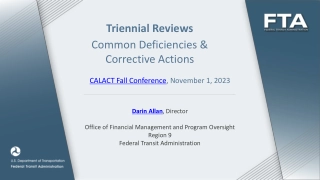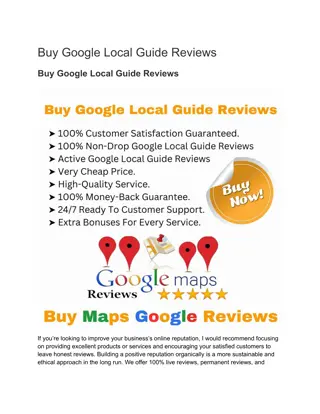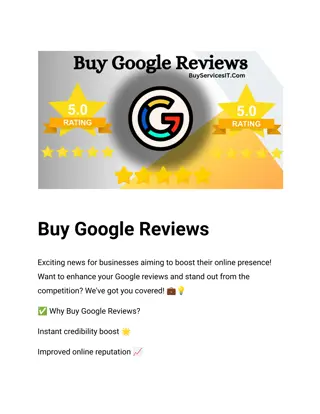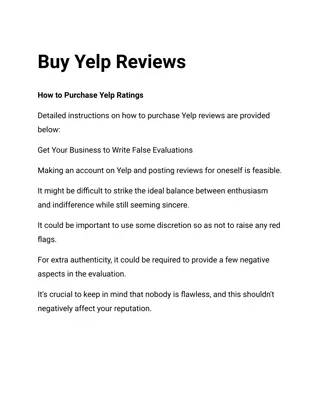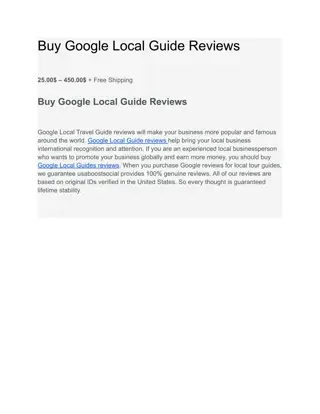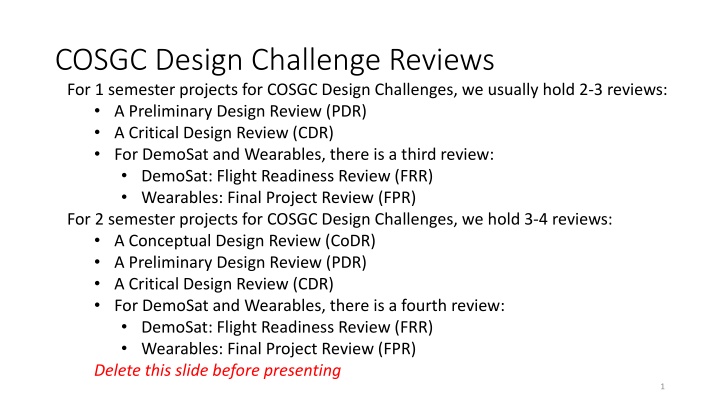
COSGC Design Challenges Reviews
For COSGC Design Challenges, reviews like Preliminary Design Review (PDR) and Critical Design Review (CDR) are essential. Different project phases require specific review processes to ensure project goals are met effectively.
Download Presentation

Please find below an Image/Link to download the presentation.
The content on the website is provided AS IS for your information and personal use only. It may not be sold, licensed, or shared on other websites without obtaining consent from the author. If you encounter any issues during the download, it is possible that the publisher has removed the file from their server.
You are allowed to download the files provided on this website for personal or commercial use, subject to the condition that they are used lawfully. All files are the property of their respective owners.
The content on the website is provided AS IS for your information and personal use only. It may not be sold, licensed, or shared on other websites without obtaining consent from the author.
E N D
Presentation Transcript
COSGC Design Challenge Reviews For 1 semester projects for COSGC Design Challenges, we usually hold 2-3 reviews: A Preliminary Design Review (PDR) A Critical Design Review (CDR) For DemoSat and Wearables, there is a third review: DemoSat: Flight Readiness Review (FRR) Wearables: Final Project Review (FPR) For 2 semester projects for COSGC Design Challenges, we hold 3-4 reviews: A Conceptual Design Review (CoDR) A Preliminary Design Review (PDR) A Critical Design Review (CDR) For DemoSat and Wearables, there is a fourth review: DemoSat: Flight Readiness Review (FRR) Wearables: Final Project Review (FPR) Delete this slide before presenting 1
TEMPLATE NOTES Each type of review requires somewhat different information, so each has its own template. You can reformat the template to fit your design, but be sure to cover at least the information requested in each review template. This template includes a lot of things. If you have difficulty with concepts, or don t think you have time to include something, just let us know! A good approach to creating effective slides is to use pictures and/or graphs but fewer words. Don t just read slides. Practice as a team, talking through each slide. Reviewers should hear the voices of every team member. Delete this slide before presenting 2
TEMPLATE NOTES The Conceptual Design Review (CoDR) should: Explain the concept of your Project Define preliminary Goals Present Concept of Operations Delete this slide before presenting 3
References This template asks for a few things that might be new to you (e.g. Project Goals, ConOps, etc.) Here are a few places to start learning about them. Project Goals ConOps Examples of ConOps Software Flow Chart Functional Block Diagram (FBD) Delete this slide before presenting 4
TEMPLATE NOTES The purpose of the CoDR is to verify that: The project goals are well-defined and understood. Verify that the Concept of Operations provides for meeting all project goals. The proposed design meets time and monetary budget available. Delete this slide before presenting 5
Later Reviews Preliminary Design Review (PDR): Have obtained and tested subsystems (e.g. individual sensors, motors ) Critical Design Review (CDR): Subsystems are integrated and working together For DemoSat: Launch Readiness Review : Is your payload fully integrated and tested? Have all safety and other flight requirements been met? For Wearables: Final Project Review (FPR) Delete this slide before presenting 6
Team Name Conceptual Design Review *Replace this text with a picture relevant to your project* Institution Team Members COSGC Robotics/Wearables Challenge (choose correct challenge) Date 7
Project Overview Name of Presenter(s) 8
Team Member Introductions (team member name here.) For each team member, include slide with: Name (include preferred name and pronouns if you want.) Major (and transfer plans if applicable.) Role on team. Something you like to do that has nothing to do with project. 9
Wearables Problem Overview (1 slide) What is the problem you are addressing? What are the current ways people deal with these problems, if any? Who is likely to encounter this problem? What are the benefits of mitigating or avoiding this problem? What are possible challenges with addressing this problem? 10
Robotics Problem Overview (1 slide) What capabilities must your robot have? What are tasks robot must complete? What problems (either internal or external to your robot) might keep your robot from being successful? What resource limitations (money, time, expertise, etc) may keep your team from building a successful robot? Anticipating these obstacles is the first step in designing a plan to avoid or mitigate their effects. 11
Wearables Design Overview (4-6 slides) What are the major components in your design? Structure/mechanical system: what might this look like? Where and how does it attach to the body? What are the supports? Include pictures! Hand drawn is fine, We just want to see preliminary ideas. Major technology dependencies: what kind of sensors will you need? What do the capabilities of the sensors need to be? (ex. Think about some issues you may have when moving, what temperature you expect to operate in, etc.) 12
Wearables Design Overview Continued Major Components (continuedd) Electrical: what does your electrical system need to do? Store data (memory), sampling sensors, provide power? Will you use already developed items? How will you use them in a novel way? How will you integrate them? 13
Project Goals (1 Slide) Project goals help to: Determine if the project is achievable within constraints of the project Ensure that all team members understand what their role is in helping the project succeed Set testing and completion requirements for tasks (how do you show that part X of the project is complete and correct?) Delete this slide before presenting 14
Example: Project Overview and Objectives Overview: The Cryo-Aerosol Dust Collection team shall build an aerosol auto- sampler that adds context and quantifiable data to the Cryospheric dust collection process. Objectives: Deploy on the surface of icy and mountainous regions for extended amounts of time with minimal human interactions Provide environmental data linking dust deposition patterns to wind events and atmospheric patterns Collect dust samples that will be turned over to NSIDC for further analysis . 15
Robotics Design Overview (4-6 slides) What are the major components in your robot s design? Structure: what are the different parts of your structure? What method of propulsion will you use? How do the motors attach? Where are electronics and batteries housed? Where are sensors mounted? Include pictures! Hand drawn is fine, we want to see preliminary ideas. Major technology dependencies: what kind of sensors, motors, batteries, etc will you need? What do the capabilities of the sensors need to be? (ex. Think about some issues you may have when moving, what temperature you expect to operate in, etc.) 16
Robotics Design Overview Continued Major Components (cont d) Electrical: what does your electrical system need to do? Store data (memory), sampling sensors, provide power? Will you use already developed items? How will you use them in a novel way? How will you integrate them? 17
Design Overview: Functional Block Diagrams (1-2 slides) (If you don t have this yet, that s ok! Keep working at it and present it at PDR) Functional block diagram Shows how systems interact with each other Mechanical will show how wearable/robot is configured, such as sensor locations Electrical Shows how power will be provided to different components. As well as how data will be transmitted, stored Examples on following slide(s) 18
Example Robotics Functional Block Diagram (electrical and data) We do not expect this slide to show your final electrical design, but would like to see some preliminary ideas. Design iterations are essential to success! 19
Software(1-2 slides) For this review, it is normal to have little (if any) software written. In the next review (PDR), you should have some sample code to show. For this review (CoDR), please show a flow chart. Start thinking about what language you will be coding in. What capabilities does your Wearable or Robot need? 20
Project Management Name of Presenter(s) 21
Management (3-4 slides) Preliminary schedule for the project Include two primary points of contact: professor or advisor and project lead We will be sending out important information in the future that MUST be communicated to all team members. 22
Management: Preliminary Timeline You must also be able to show that you have enough time to complete your design. Your first timeline will be a rough estimate. The project manager should update as project proceeds. Don t forget to include down time (for example, teams usually can t order parts from mid-December to mid-January, and usually don t get much work done in that time.) Be realistic in your time estimates. Use the rule of Pi (things take pi times as long as you will think )
Preliminary Timeline, continued Factor in time necessary to get parts ordered and have them shipped. Include time for design and fabrication. For example, teams that to 3-D print their structure typically take around 3 months to complete design and printing.
Preliminary Budget To evaluate whether your design seems feasible or not, you must be able to show that you have enough money to complete your design. Check with your project mentor to find out how much money they have allocated for your project, and what that includes (e.g. will they supply 3-D printing supplies, or must you purchase filament, etc?) Your first budget will be an estimate, give a ballpark cost. For example, what does an Arduino cost? The sensor(s) you are proposing to use? Structural materials? Batteries? Your budget should include enough money (a margin) for replacement parts, etc.
Risks and Worries What are your biggest worries or potential failure points with your conceptual design? Items identified should be completely mitigated through your design efforts and fully addressed by the Critical Design Review (CDR; the third review) 26
Conclusion (1-2 slides) For conclusion, summarize the following: Restate project goals Issues, concerns What questions do you have for us? Plan for where you will take your design from here: What do you need to investigate further (next steps)? Are you ready to purchase subsystem hardware so you can start testing it? You will be asked about status of subsystems in the next review (PDR.) Where do you hope to be by the next review? Be as specific as possible. 27


